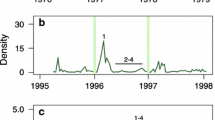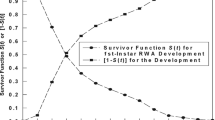Abstract
The development rate of insects at hourly fluctuating temperatures is not infrequently different from that at constant temperatures even when the averages of these temperatures are the same. This temperature-dependent development phenomenon has been known as the Kaufmann effect. However, its theoretical analysis has not yet been successfully carried out owing to the insufficiency of mathematical insight especially into quantitative expressions. In insect development, the interrelationships among the three environmental temperatures, namely, the constant and alternating temperatures controlled in the laboratory and the hourly fluctuating temperatures in the natural environment, have not been clarified. Here, we completely succeeded in analyzing this phenomenon and in elucidating the interrelationships by introducing the components of the nonlinear SSI development model, the second derivative, the cosine-wave model of hourly fluctuating temperatures and their variance, and Taylor series. As a result, it has been possible to predict the development rate at fluctuating temperatures in the natural environment using prospective daily maximum, minimum and average temperatures and the development rate at constant temperatures without conducting experiments at alternating temperatures.






Similar content being viewed by others
References
Behrens W, Hoffmann KH, Kempa S, Gäßler S, Wallner GM (1983) Effects of diurnal thermoperiods and quickly oscillating temperatures on the development and reproduction of crickets, Gryllus bimaculatus. Oecologia 59:279–287
Bryant SR, Bale JS, Thomas CD (1999) Comparison of development and growth of nettle-feeding larvae of Nymphalidae (Lepidoptera) under constant and alternating temperature regimes. Eur J Entomol 96:143–148
DiCiccio TJ, Efron B (1992) More accurate confidence intervals in exponential families. Biometrika 79:231–245
DiCiccio TJ, Efron B (1996) Bootstrap confidence intervals (with discussion). Statist Sci 11:189–228
Fantinou AA, Perdikis DC, Chatzoglou CS (2003) Development of immature stages of Sesamia nonagrioides (Lepidoptera: Noctuidae) under alternating and constant temperatures. Environ Entomol 32:1337–1342
Feller W (1966) An introduction to probability theory and its applications, vol II. Wiley, New York
Foley DH (1981) Pupal development rate of Heliothis armigera (Hubner) (Lepidoptera: Noctuidae) under constant and alternating temperatures. J Aust ent Soc 20:13–20
Hagstrum DW, Milliken GA (1991) Modeling differences in insect developmental times between constant and fluctuating temperatures. Ann Entomol Soc Am 84:369–379
Ikemoto T (2005) Intrinsic optimum temperature for development of insects and mites. Environ Entomol 34:1377–1387
Ikemoto T (2008) Tropical malaria does not mean hot environments. J Med Entomol 45:963–969
Ikemoto T, Kurahashi I, Shi PJ (2012) Confidence interval of intrinsic optimum temperature estimated using thermodynamic SSI model. Insect Sci. doi:10.1111/j.1744-7917.2012.01525.x
Liu SS, Chen FZ, Zalucki MP (2002) Development and survival of the diamondback moth (Lepidoptera: Plutellidae) at constant and alternating temperatures. Environ Entomol 31:221–231
Ludwig D, Cable RM (1933) The effect of alternating temperatures on the pupal development of Drosophila melanogaster Meigen. Physiol Zool 6:493–508
Messenger PS, Flitters NE (1958) Effect of constant temperature environments on the egg stage of three species of Hawaiian fruit flies. Ann Entomol Soc Am 51:109–119
Messenger PS, Flitters NE (1959) Effect of variable temperature environments on egg development of three species of fruit flies. Ann Entomol Soc Am 52:20–191
Miyashita K (1971) Effects of constant and alternating temperatures on the development of Spodoptera litura F.: Lepidoptera: Noctuidae. Appl Entmol Zool 6:105–111
Ragland GJ, Kingsolver JG (2008) The effect of fluctuating temperatures on ectotherm life-history traits: comparisons among geographic populations of Wyeomyia smithii. Evol Ecol Res 10:29–44
Ruel JJ, Ayres MP (1999) Jensen’s inequality predicts effects of environmental variation. Trends Ecol Evol 14:361–366
Schoolfield RM, Sharpe PJH, Magnuson CE (1981) Non-linear regression of biological temperature-dependent rate models based on absolute reaction-rate theory. J Theor Biol 88:719–731
Sharpe PJH, DeMichele DW (1977) Reaction kinetics of poikilotherm development. J Theor Biol 64:649–670
Shi P, Ikemoto T, Egami C, Sun Y, Ge F (2011) A modified program for estimating the parameters of the SSI model. Environ Entomol 40:462–469
Tanigoshi LK, Browne RW, Hoyt SC, Lagier RF (1976) Empirical analysis of variable temperature regimes on life stage development and population growth of Tetranychus mcdanieli (Acarina: Tetranychidae). Ann Entomol Soc Am 69:712–716
Worner SP (1992) Performance of phenological models under variable temperature regimes: consequences of the Kaufmann or rate summation effect. Environ Entomol 21:689–699
Wu KJ, Gong PY, Ruan YM (2009) Estimating developmental rates of Helicoverpa armigera (Lepidoptera: Noctuidae) pupae at constant and alternating temperatures by nonlinear models. Acta Entomologica Sinica 52:640–650
Yamamura (1989) Effect of aggregation on the reproductive rate of populations. Res Popul Ecol (Present name is Popul Ecol) 31:161–168
Acknowledgments
We sincerely thank Dr. Kohji Yamamura for his invaluable suggestions at the start of this study.
Author information
Authors and Affiliations
Corresponding author
Appendix: derivation of the SSI model for fluctuating temperatures
Appendix: derivation of the SSI model for fluctuating temperatures
In the text, the SSI model for fluctuating temperatures is derived employing that for constant temperatures. The model equation provides the expected value of a function, the variable of which is random.
Let f be a smooth function. The Taylor series of f(x) at point x 0 is given by the form
By ignoring the third and higher order terms, it follows that in the neighborhood of x 0,
Let X be a random variable and let us denote E[X] with the expected value of X, as the variance V [X]. Using the above argument, in the neighborhood of E[X], f(X) can be approximately written by
Note that f (X) is a random variable. Taking the expected values of both sides of Eq. 26, we find
If V[X] is invariant for any X, E[f(X)] is expressed as a function of E[X] by Eq. 27.
Let us denote T f as fluctuating temperatures; T f is a random variable. Write T Af = E[T f]. In the SSI model for fluctuating temperatures, r f(T Af) is obtained by replacing f and X of Eq. (27) with r c and T f, respectively, that is,
Jensen’s inequality
In order to explain the relationship between the graphs of the constant temperatures model r c(T c) and the fluctuating temperatures model r f(T Af), we introduce the following theorem known as “Jensen’s inequality.” For details, refer to Feller (1966).
Theorem
Let X be a random variable. If f is a convex function, then
If f is a concave function, then
When the two graphs are plotted using the common horizontal axis T, “Jensen’s inequality” implies that r f(T) ≥ r c(T) for T to satisfy r ″c (T) > 0; r f(T) ≤ r c(T) for r ″c (T) < 0.
Rights and permissions
About this article
Cite this article
Ikemoto, T., Egami, C. Mathematical elucidation of the Kaufmann effect based on the thermodynamic SSI model. Appl Entomol Zool 48, 313–323 (2013). https://doi.org/10.1007/s13355-013-0190-6
Received:
Accepted:
Published:
Issue Date:
DOI: https://doi.org/10.1007/s13355-013-0190-6




